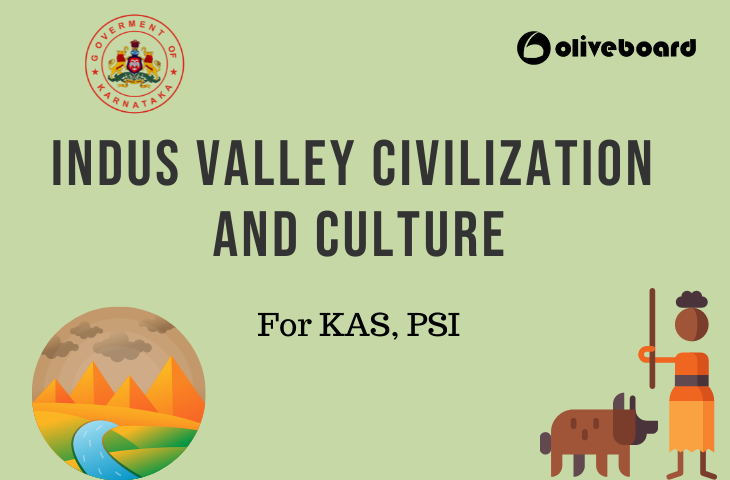India is known for its cultural diversity. Each culture has its own civilizational connection. Indian civilization and culture is an important part of many competitive exams. In this blog you will get a glimpse of Indian heritage and culture of Indus Valley civilization. If you are preparing for KAS, PSI, KPTCL, Karnataka Police Constable exams, OliveBoard has mock tests for each exam. You can visit the Karnataka Exam Section on our website for more information.
Indian Culture and Civilization
Indian heritage and culture starts with ancient Indian civilization. Each civilization contributed to Indian cultural diversity. So we will go through Indian civilization and culture together.
We can divide history of Indian heritage and culture into 2 categories
- Indian Civilization and Culture during Ancient India
- Mediaeval Indian heritage and culture
Indus Valley Civilization
The cultural development in ancient India started to happen during the chalcolithic age( Metal Age). Before that the evidence of settlement of human beings in India during the three stone ages are found in Bhimbetka caves in Madhya Pradesh. In forms of rock shelter paintings. At that time there were no human settlements which can be considered as an Indian civilization and culture.
During the bronze age people started to live beside the indus valley and slowly the residency flourished in the form of Indian civilization and culture which is known as Indus valley civilization.
Discovery
Discovery of Indian civilization and culture, Indus valley civilization
Indus valley civilization is believed to be a contemporary civilization to Mesopotamia, Egypt and China. Indian heritage and culture of Indus valley civilization was first discovered by Dr dayaram sahani in 1992 near the bank of river ravi in harappa village in Montgomery district of West Punjab which is now in Pakistan.The excavation was carried at the site under supervision of the then director general of archeological department of India Sir John Marshall.
As the newly found civilization was in Harappa district the Indian civilization and culture was called as Harappan civilization. Further the excavation was taken up by Dr R.D.Banarjee and in 1922 he found Mohenjodaro (which means mound of dead in Sindhi language) in larkhan district of Sindh. Further the excavation was carried out under different archeologists and more sites belonging to the same civilization, Indian heritage and culture were discovered. As More and more sites were discovered near Indus valley, the civilization was renamed as Indus valley civilization. The civilization was spread from south wards and eastward of Sindh and Punjab. Its spread was greater than Egypt and Mesopotamia.
The Indian heritage and culture of disposing of their dead bodies by performing cremation or burial, a large burial site was found in mohenjodaro which gives information about their burial practices. They used coffins made up of wood and bricks they also practiced pot burial, with pairs of bodies
Township – Indus Valley Civilization
The basement of Indian heritage and culture is Indus valley civilization. This Indian civilization and culture is well known for its well established township.
The Indus valley civilization had well developed towns. The infrastructure and planning was in such a way that the citizens were living comfortably. The people of this Indian Heritage and culture were the first to build a scientific drainage system. The cities were built in an unique way. East and west part of the cities had residential hubs and citadel built on higher platforms respectively. Which was surrounded by a massive brick wall. The streets of this Indian civilization and culture were 13-34 feet wide and they were straight. Each straight street is cut at right angles. The archaeologists believe that there were street lights as well.
Economy
Indian Civilization and Culture of economy in Indus valley civilization-
Indian heritage and culture was well developed in all forms of economic activities such as agriculture, industry and crafts & trades. Barter system was in use for exchanging commodities. Weights and measures made up of shells and known metals were used which contributed to the Indian heritage and culture.
Contributing to the agriculture into the Indian heritage and culture,their main crops were wheat and barley along with that they used to grow sesame, mustard, and cotton. Their grown cotton was known as shindone by Greeks. The granaries were used to store surplus grains.
Art of Indus Valley Civilization
Art of Indian civilization and culture of Indus valley civilization included pottery. Pottery at that time was plain but as civilization developed black painted pottery were being used. As they developed Wide variety of semi precious stones were used to manufacture beads. The good quality painted pottery contained pictorial motifs which consisted of geometrical patterns like horizontal lines, circles, leaves, plants and trees.These potteries are the gift to the Indian heritage and culture. Figures of fish and peacocks were also found on some pottery.
Small and Square or rectangular shaped seals made up of terracotta,Ivory, or steatite were used,seals were finely engraved with various animals like bull unicorn, elephant, antelope, and humans. All seals contained pictorial writing. Their direction of writing was from right to left and in some cases the direction was from right to left in the first line and then left to right on second.
The technique of cutting and polishing the seals with white lustre was a unique invention of a key point of the Indian heritage and culture which is indus valley civilization.
Appearance
Indian cultural diversity is known for its clothing and other cultural differences. During Indus valley civilization the Indian heritage and culture of clothing was simple. Both men and women used to wear shawls and dhoti and were made up of wool and cotton ornaments.
Jewellery
Indian civilization and culture of jewellery is pale without the usage of gold. The prime Indian civilization and culture, Indus valley civilization people used, different designs of ornaments made up of gold silver and precious stones were worn by both genders. girdles,nose stud earrings and anklets worn only by women. Face paint lipstick and collyrium were also used.
They knew the art of dancing and music which praises the Indian civilization and culture. Their means of amusement were chess,dice game, hunting, bull fighting, cock fighting, fishing and clay modelling. In many Indian heritage and culture, nature was considered as the God.
Beliefs
The people of the Indian civilization and culture, Indus valley Civilization were nature worshippers as they used to worship fire, river, birds, serpents and trees. Pashupatinath was their chief male deity and was represented in many seals as sitting in a Yogic posture with three faces and two horns,he is surrounded by elephant,tiger,rhino and bullock all looking in different directions and two deer appear on his feet.
Mother goddess was their chief female deity.phallus (linga) and yoni worship was prevalent.They used to believe in supernatural powers and demons. In the rich Indian heritage and culture we have many mythologies and tales of Gods.
As it is a long lost Indian civilization and culture found in the 20th century and their written language is still unknown. still many discoveries are being made about the civilization,so it becomes difficult to analyse and estimate about society, Indian heritage and culture of indus valley civilization.

Hello there! I’m a dedicated Government Job aspirant turned passionate writer & content marketer. My blogs are a one-stop destination for accurate and comprehensive information on exams like Regulatory Bodies, Banking, SSC, State PSCs, and more. I’m on a mission to provide you with all the details you need, conveniently in one place. When I’m not writing and marketing, you’ll find me happily experimenting in the kitchen, cooking up delightful treats. Join me on this journey of knowledge and flavors!
